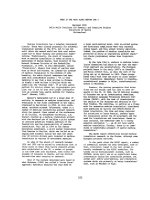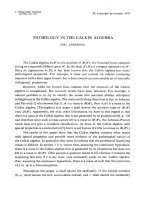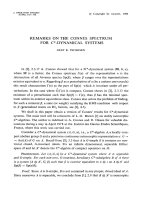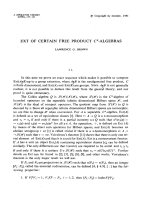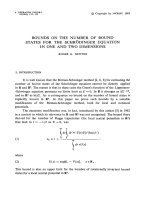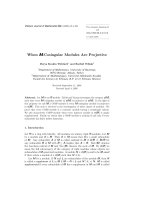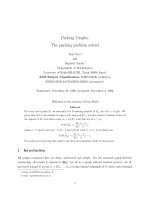Báo cáo toán học: "When can the sum of (1/p)th of the binomial coefficients have closed form" pot
Bạn đang xem bản rút gọn của tài liệu. Xem và tải ngay bản đầy đủ của tài liệu tại đây (98.86 KB, 7 trang )
When can the sum of (1/p)th of the binomial
coefficients have closed form?
Marko Petkovˇsek
University of Ljubljana
Ljubljana, Slovenia
Herbert S. Wilf
∗
University of Pennsylvania
Philadelphia, PA 19104-6395
Submitted: May 23, 1996; Accepted: November 25, 1996
Abstract
We find all nonnegative integer r, s, p for which the sum
sn
k=rn
pn
k
has
closed form.
Let
f
p,r
(
n
)=
rn
k=0
pn
k
.
where 0
≤
r
≤
p
are fixed integers. This is a definite sum in the sense that the
summation limits and the summand are not independent. As we all know,
f
r,r
(
n
)=2
rn
,
f
2r,r
(
n
)=
1
2
4
rn
+
2
rn
rn
.
Thus
f
r,r
(
n
) is a hypergeometric term, and
f
2r,r
(
n
) is a linear combination of two
hypergeometric terms.
∗
Supported in part by the Office of Naval Research
1
the electronic journal of combinatorics 4 (no. 2) (1997), #R21 2
Following [PWZ], let us say that a function f(n)hasclosed form if there is a fixed
integer m and hypergeometric terms {t
i
(n)}
m
i=1
such that f(n)=
m
i=1
t
i
(n)forall
sufficiently large n. Our main results are as follows.
Theorem 1 Let 0 <r<pand p =2r.Thenf
p,r
(n) does not have closed form.
Theorem 2 Let 0 ≤ r<s≤pbe fixed integers. Then
S
p,r,s
(n)=
sn
k=rn
pn
k
does not have closed form, unless r =0,p=2s,orp=s=2r,orr=0,p=s.
1 Reduction to an indefinite sum
We begin by briefly discussing the method. One might anticipate that we would
first find a recurrence formula that, say, f
p,r
(n) satisfies, using Zeilberger’s algorithm,
and then prove, using Petkovˇsek’s theorem, that the recurrence has no closed form
solution. As described in [PWZ], this method is quite effective in many cases.
In the present situation, however, the recurrence that f
p,r
(n) satisfies will grow
in complexity with p, r.Soforeachfixed p, r the argument would work, but without
further human input it could not produce a general proof, i.e., a proof for all p, r.
This is somewhat analogous to the sums of the pth powers of all of the binomial
coefficients of order n. There too, the methods described in [PWZ] can show that no
closed form exists for specific fixed values of p, but the general question remains open
for p ≥ 9 or thereabouts.
Hence we resort to a somewhat different tactic. We will first reduce the definite
sum f
p,r
(n)toanindefinite sum, and then we invoke Gosper’s algorithm to show that
the resulting indefinite sum is not Gosper summable.
Indeed, since
n
k
=
j
p
j
n−p
k−j
by the Chu-Vandermonde convolution formula,
we have
f
p,r
(n +1) =
rn+r
k=0
pn + p
k
=
rn+r
k=0
j
p
j
pn
k − j
=
j
p
j
rn+r−j
l=0
pn
l
=
r
j=0
+
p
j=r+1
p
j
rn+r−j
l=0
pn
l
=Σ
I
+Σ
II
,
the electronic journal of combinatorics 4 (no. 2) (1997), #R21 3
say. Now
Σ
I
=
r
j=0
p
j
rn
l=0
+
rn+r−j
l=rn+1
pn
l
= f
p,r
(n)
r
j=0
p
j
+
r− 1
j=0
p
j
r−j
i=1
pn
rn + i
,
Σ
II
=
p
j=r+1
p
j
rn
l=0
−
rn
l=rn+r−j+1
pn
l
= f
p,r
(n)
p
j=r+1
p
j
−
p
j=r+1
p
j
j−r−1
i=0
pn
rn − i
.
Therefore,
f
p,r
(n +1)=2
p
f
p,r
(n)+
r−1
j=0
p
j
r−j
i=1
pn
rn + i
−
p
j=r+1
p
j
j−r−1
i=0
pn
rn − i
.
For each fixed p and r this is a first-order inhomogeneous recurrence with a hyperge-
ometric (and closed form) right hand side. Solving it, we find that f
p,r
(n)/2
pn
can be
written as an indefinite sum,
f
p,r
(n)=2
pn
n
k=0
t
k
,
where
t
k
=2
−pk
r−1
j=0
p
j
r−j
i=1
pk − p
rk − r + i
−
p
j=r+1
p
j
j−r−1
i=0
pk − p
rk − r − i
is a hypergeometric term for each fixed p and r. Note that this means f
p,r
(n)satisfies
a homogeneous second-order recurrence with polynomial coefficients in n, which could
be written down explicitly.
Example. Take p =3andr=1.Thenwehaveshownthat
f
3,1
(n)=
n
k=0
3n
k
=8
n
n
k=0
8
−k
3k − 3
k
− 4
3k − 3
k − 1
−
3k − 3
k − 2
=8
n
1
2
−
n
k=2
5k
2
+ k − 2
2
3k+1
(k − 1)(2k − 1)
3k − 3
k
(n ≥ 1)
the electronic journal of combinatorics 4 (no. 2) (1997), #R21 4
2 Application of Gosper’s algorithm
In view of the result of the previous section, we now have that f
p,r
(n)hasaclosed
form if and only if t
k
is Gosper-summable. To see if this is the case we “run” Gosper’s
algorithm on t
k
.
In Step 1 of Gosper’s algorithm
1
we rewrite t
k
as
t
k
=
pk
rk
2
pk
pk
p
P
k
,k>0,
where P
k
is a polynomial in k,
P
k
=
r−1
j=0
p
j
r−j
i=1
rk
r−i
pk−rk
p−r+i
p
r−i
−
p
j=r+1
p
j
j−r−1
i=0
rk
r+i
pk−rk
p−r−i
p
r+i
,
and t
0
=1.Then
t
k+1
t
k
=
p
r
pk
p
2
p
r(k+1)
r
(p−r)(k+1)
p−r
P
k+1
P
k
,k>0,
is a rational function of k.
In Step 2 we note that the roots r
i
of
pk
p
are 0, 1/p, ,(p −1)/p while the
roots s
j
of
r(k+1)
r
(p−r)(k+1)
p−r
are −1, −(r − 1)/r, ,−1/r; −1, −(p − r − 1)/(p −
r), ,−1/(p−r). But s
j
− r
i
is never a nonnegative integer. Hence
t
k+1
t
k
=
a
k
c
k+1
b
k
c
k
is a possible Gosper’s normal form for t
k+1
/t
k
,where
a
k
=
p
r
pk
p
,
b
k
=2
p
r(k+1)
r
(p − r)(k +1)
p−r
,
c
k
= P
k
.
1
Our description of the steps of Gosper’s algorithm follows the exposition of Chapter 5 of [PWZ].
the electronic journal of combinatorics 4 (no. 2) (1997), #R21 5
In Step 3 we have to determine the degrees and leading coefficients of a
k
, b
k
and
c
k
.Obviously,
deg a
k
=degb
k
=p,
lc a
k
=
p
r
p
p
p!
,
lc b
k
=2
p
r
r
r!
(p−r)
p−r
(p−r)!
.
When is lc a
k
=lcb
k
,orequivalently,
p
p
=2
p
r
r
(p−r)
p−r
?(1)
Claim: All integer solutions 0 <r<pof equation (1) are of the form
p =2r.
To prove the claim, let p =2
k
q,r=2
m
s,whereq,sare odd. Then (1) turns into
2
kp
q
p
=2
p+mr
s
r
(2
k
q − 2
m
s)
p− r
. (2)
For an integer n and a prime u,letε
u
(n)denotethelargestexponentesuch that
u
e
divides n.LetLand R denote the left and right sides of (2), respectively. So
ε
2
(L)=kp.
If k<m,ε
2
(R)=kp + p − r(k − m),sop=r(k−m)<0, which is false.
If k = m, ε
2
(R) >mp+p,sok>m+ 1, a contradiction.
If k>m,ε
2
(R)=mp + p ,sok=m+ 1 and (2) turns into
q
p
= s
r
(2q − s)
p− r
.
Let u be an odd prime, ε
u
(q)=a,ε
u
(s)=b.
If a<b,ε
u
(q
p
)=ap and ε
u
(s
r
(2q −s)
p− r
)=br +a(p−r), so a = b, contradiction.
If a>b,ε
u
(q
p
)=ap and ε
u
(s
r
(2q − s)
p−r
)=br + b(p − r)=bp,soa=b,
contradiction.
It follows that a = b.Soqand s have identical prime factorization and are
therefore equal. Thus p =2
k
q=2
m+1
s =2r, proving the claim.
Since we are assuming that p =2r, the leading coefficients of a
k
and b
k
are
different, and we are in Case 1 of Gosper’s algorithm.
the electronic journal of combinatorics 4 (no. 2) (1997), #R21 6
Obviously deg c
k
=degP
k
≤p,soanypolynomialx
k
satisfying Gosper’s equation
a
k
x
k+1
− b
k−1
x
k
= c
k
, (3)
must be constant. After a little computation we find that the coefficient of k
p
in P
k
is
p − r
(p − 2r)p!
(p
p
− 2
p
r
r
(p − r)
p−r
),
which is non-zero. Comparing leading coefficients in Gosper’s equation we find that
x
k
=
p − r
(p − 2r)
p
r
.
But then one can verify that the coefficient of the first power of k in the polynomial
on the left of (3) is (−1)
p−1
(p − r)/(p − 2r), while the corresponding coefficient on
the right is (−1)
p− 1
(p − r)/p. This discrepancy proves that Gosper’s equation has no
polynomial solution, and thus f
p,r
(n)noclosedform,whenp=2r, completing the
proofofTheorem1.
To prove Theorem 2, we see that if r =0thenS
p,r,s
(n)=f
p,s
(n), and if s = p then
S
p,r,s
(n)=2
pn
− f
p,r
(n)+
pn
rn
, so in these two cases the assertion follows immediately
from Theorem 1.
If r =0ands=pthen write
S
p,r,s
(n)=f
p,s
(n) − f
p,r
(n)+
pn
rn
.
As in the proof of Theorem 1, f
p,s
(n) − f
p,r
(n) can be written as the indefinite sum
of two hypergeometric terms, one similar to
pn
rn
and the other to
pn
sn
.Sincer<s,
these two terms are not similar to each other, hence S
p,r,s
(n) has a closed form if and
only if both f
p,s
(n)andf
p,r
(n)haveit
2
. According to Theorem 1, this is possible only
if p =2s=2r, contradicting the assumption r<s. 2
3 Discussion
A number of interesting combinatorial sequences have already been proved not to be of
closed form. In [PWZ] there are several examples, including the number of involutions
2
See section 5.6 of [PWZ]
the electronic journal of combinatorics 4 (no. 2) (1997), #R21 7
of n letters, the “central trinomial coefficient,” and others. The arguments there were
made sometimes with Gosper’s algorithm, and sometimes with Petkovˇsek’s algorithm,
which decides whether a linear recurrence with polynomial coefficients does or does
not have closed form solutions.
In the earlier literature there are one or two related results. One elegant and
difficult theorem of de Bruijn [Bru] asserts that the sums
k
(−1)
k
2n
k
s
do not have
closed form if s is an integer ≥ 3. The idea of his proof was to compare the actual
asymptotic behavior of the given sum, for fixed s and n →∞, with the asymptotic
behavior of a hypothetical closed form, and to show that the two could never be the
same.
In Cusick [Cus] there is a method that can, in principle, yield the recurrence that
is satisfied by the sum f
p
(n)=
k
n
k
p
,forfixedp, and a few examples are worked
out. Zeilberger’s algorithm (see, e.g., [PWZ]) can do the same task very efficiently.
Using these recurrences, it has been shown, by Petkovˇsek’s algorithm, that these sums
f
p
(n) do not have closed form if p ≤ 8 (but, starting with 6th powers, we have proved
this only over fields which are at most quadratic extensions of the rational number
field). The general case for these pth power sums remains open, as far as we know.
McIntosh [McI] has investigated the order of some related recurrences, as a function
of p, and also showed that the Ap´ery numbers cannot be expressed in a certain form
which is a restriction of our notion of closed form. Again, with Petkovˇsek’s algorithm
it is quite simple to show that the Ap´ery numbers are not of closed form, in the wider
sense that we use here.
References
[Bru] N. G. de Bruijn, Asymptotic Methods in Analysis, Bibliotheca Mathematica,
Vol. 4, North Holland Publishing Co., Amsterdam, 1958 (reprinted by Dover
Publications, Inc., 1981).
[Cus] T. W. Cusick, Recurrences for sums of powers of binomial coefficients, J.
Comb. Theory Ser. A
52
(1989), 77–83.
[McI] Richard J. McIntosh, Recurrences for alternating sums of powers of binomial
coefficients, J. Comb. Theory Ser. A
63
(1993), 223-233.
[PWZ] Marko Petkovˇsek, Herbert S. Wilf and Doron Zeilberger, A = B,AKPeters,
Ltd., Wellesley, MA, 1996.
